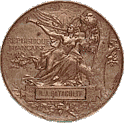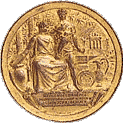History
Samovar is purely Russian invention. Its origin is connected with tea. Tea was delivered to Russia from the territory of West Mongolia in the 17-th century and was used as medicine among the nobility.
Tea was a competitor of sbiten, the most favourite drink in Russia. Its components are: hot water, medicinal herbs and honey.
In the 18-th century in the Urals and Tula samovar-kitchens were invented, they were divided into three parts Ч in two of them the meals was cooked, in the third Ч tea. Sbitennik and samovar-kitchen were samovar prototypes.
There are different versions of the first samovars manufacture, they were produced in the Urals, Moscow, Saint-Petersburg, Tula, later in Vladimirskaja,
Jaroslavskaja and Vjatskaja provinces. The first samovar factory was founded in Tula by Nasar Usitsin in 1778.
The town of gunsmiths became familiar to all the world as the center of samovar manufacture due to rich ore deposits, highly qualified masters who worked metals and location of Tula in the vicinity of Moscow.
Samovar manufacture appeared to be very profitable. Handicraftsmen quickly became manufacturers, workshops Ч samovar manufactures. In 1826 there were eight samovar factories, in 1896 Ч seventy.
Samovars were made from cupronic-kel, red and green copper, pinchbeck, in some cases Ч from silver. Sometimes they were plated with gold, silver, but basic metal was always Ч brass. In the course of centuries samovar shapes changed. By the end of the 19-th century their quantity reached 165. It was almost impossible to mechanize samovars manufacture completely. Tools were also unchanged. By hand assembly five-six samovars per day were produced.


The highest peak of samovar manufacture in Tula is related to the 80s of the 19-th century.
Samovar was not only the feature of home comfort, the symbol of Russian hospitality, but also the sign of good circumstances.
Among monuments of folk domestic art samovars occupy specific place.
They may be considered not only as domestic utensils, some of them are real works of applied arts. Each true master wanted to astonish the customers be their creative fantasy.
Strict design, durability in combination with decorative qualities caused interest to samovars on the part of the people all over the world.
Tula samovars were presented at the exhibitions in Russia and abroad.

Paris - 1889

Chicago - 1893

London - 1909

N.Novgorod - 1896
The manufacturers taking part at the exhibitions were constantly awarded with medals, the reprints of them were presented on the samovar walls.
Tula samovars were spread all over Russia. At the fairs there were sold samovars of different shapes: vase-shaped, pear-shaped, wine-glass-shaped and others.
Prices reduction in the process of manufacture caused standardization of samovar shapes. The so-called cylindrical samovars were widely spread.


In Tula coal samovars were produced, the water in them was heated by charcoal, kerosene samovars and combined variants, the water in which was heated by any type of fuel.
Prices were fixed in dependence of a shape, material and dimension. Simple samovars were sold by poods. Articles of complicated shapes (presents, made to order) were sold by the piece.
During all the 19-th century portable samovars were produced in Tula, as a rule, they were many-sided, cubic, right-angled.


Production technology was greatly improved for two hundred years. There are used presses, conveyor lines, casting under pressure. At "Shtamp" plant nickel-plating automatic line was introduced. Some samovars are decorated with art rolling. The plant produces samovars of different types: coal Ч of six versions, from 1956 Ч electrical, volume 2-3 litres, for buffets, combined and painted.
Folk traditions exist, develop. Beautiful samovars made as presents are produced at this plant. Tula samovars were often awarded with medals at native and international exhibitions.